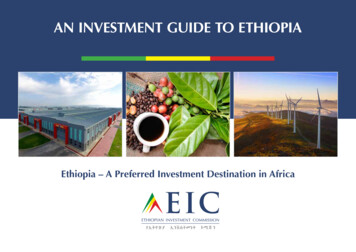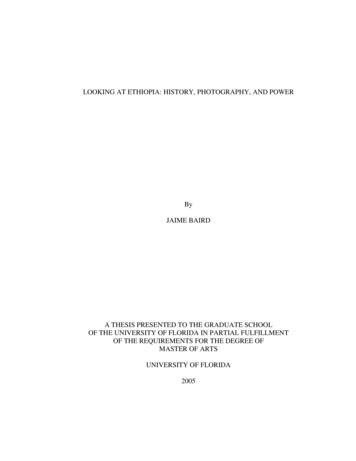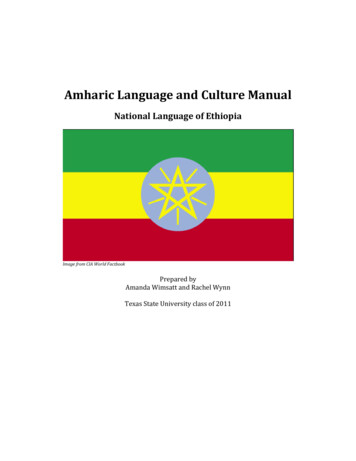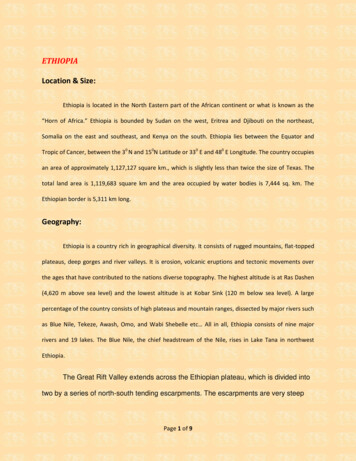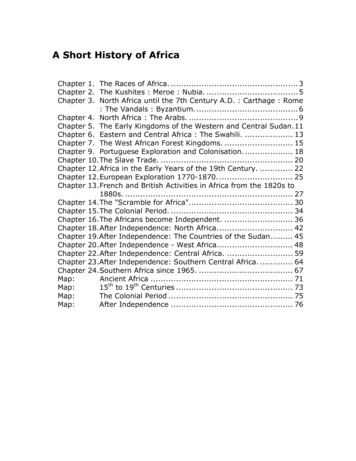
Transcription
Ethiopia: Brief History,Energy demand and its implication onEnvironmentBy: Girma G Gonfa (PhD)
Geographic location Ethiopia: area of 1.12 million squareKilometers (slightly less than twice the size ofTexas), is located at 4 and 14 degree north, 33and 48 degrees east. Situated in the Horn ofAfrica, Ethiopia is bordered by Eritrea to thenorth, Sudan to the west, Kenya to the south,Somalia to the east and Djibouti to thenortheast.Landlocked
time difference: UTC 3 (8 hours ahead of Washington, DC duringStandard Time)
Population 79 Million, (second populous)Major languages are: Amharic, Afaan Oromoo,Sidama, Tigrigna, Somali,ReligionOrthodox 43.5%, Muslim 33.9%, Protestant 18.6%,traditional 2.6%, Catholic 0.7%, other 0.7%
The oldest nation homes the ancestor of humanityLucy – Australopithecus Afarensis- 3.2 million yrs old, discovered in1974 by an American ProfessorDonald Johanson Ethiopia you are all EthiopiansLucy, the most complete skeletonPre-History
diverse- historical- natural and cultural tourist attraction sites.monuments, churches, monasteries andmosques,-contrasting natureSemien Mountains(4620m or 15,175ft)toDanakil Depression,(125m below SL)
Eight sites are registered by the United NationsEducation Science and Culture Organization(UNESCO) as world heritage sites.
Ancient civilization Ethiopia (Axumite) was the powerful statebetween the Roman Empire and Persia. The granite obelisk 1700 yrs old160 ton, (24m) looted by italiansand returned in April 2005 The one that fell to the grounddue to structural collapse? is 33m Markers for underground burialchambers
Christianity was introduced to the country inthe 4th Century and thus Axum is known tobe center of religion and civilization.The first Ethiopian Orthodox Church (Zionmariam) is African oldest churchAxum went into decline between the 7th and8th centuries AD.Isolated from Europe Christianity
The famous bete -giorgis churchThe power moved southward to yeha-LalibelaLalibela is famous for its 11 rock-hewn churchesbuilt in the 12 th century and still in use
In 15th c Portuguese re-established contact withIntention:Control the Indian Ocean andto convert Ethiopia to Roman Catholicism.A century of religious conflict followed resultingin the expulsion of all foreign missionaries in the1630sBecame hostile to foreign Christianity andEuropeans which was the cause for isolation tomid 19th century
In the 17th and 18th Century, power moved toGONDAR. It is known for its castles built by EmperorFasiladas and his successors from 1632-1730 at theroyal enclosureEra of the Princes wascharacterized by the turmoilcaused by local rulerscompeting against each other (dark age)The New Ethiopia (current shape)Aggressive expansion by Menilik II, the southern territoriesaround 1880’s
The Oromo states and others became part ofEthiopia.The Oromos have an egalitarian social system calledGADA. GADA was a form of constitutional governmentand social system. DEMOCRATICLeaders are democratically elected every eight years.Social classification is according to age with definedresponsibility.
To run for the presidency (ABA GADA), one mustpass through all the stages.The system is in place to remove corrupts.Gada is still practiced to limited scale.
The new Ethiopia is known as a country of mosaicof cultures.More than 80 languages and 200 dialects arespoken throughout the country.These ethnic groups have their own way ofclothing, hair styles, songs, dances and arts231Ethiopians have unique calendar, and uniquealphabet.
The only African country never colonizedAgriculture is the major revenue generatorcoffee, grain sorghum, andcastor bean-originatedfrom EthiopiaEducation: Traditional and ModernTraditional; Church andMonasteries.has history of 1500 Yrs.
In the 5th century, monasteries were also introduced by the monks fromSyria. These monks initiated the translation of the bible into Ge’ez- one ofthe ancient languages in Ethiopia. These monasteries also began the firstform of schools. Has curriculum with different stagesIts organization limited access to many.Contributed to literature, art, arithmetic,astronomy,Equivalently Madrasa run by mosques.
Natural Resources:Rivers, forest, wildlife, etc,
At the turn of 19th Century, forest coverage was35-40%Pressure from rapid population growth (energyand farmland)deforestation coverage 9%resulting soil erosion; desertification; watershortages and generally environmentaldegradationEnergy demand and sources and consumption only 16% have a potential to access to the grid. But only 6% accessed as it is not affordable to many
Only 10% is supplied by electric power, the balance is fromwood fuel and dung.Aggressive construction of Hydropower plants—targeting export-scattered settlement, in some case migrating nomadsThe need for alternative energy source is SOLAR POWER it is clean and promotes environmental issuesMore practical for a country like EthiopiaRemote areas can be accessed
Improves the life style of rural communitysmoke free light healthy and productive societyCan be used to pump water for irrigationFor cattle: In pastoralist community
Current statusSolar Energy Foundation, German’s NGO,has installed PV to one remote district It is also assisted by Clinton’s Foundation Ethio Telcom is powering its cellulartowers (T&R) with solar panel. Few individuals and schools are using topower small electronic devicesAnd yet can be said non-existentAFRICA NEEDS THIS TECHNOLOGY!!
Thank you
(UNESCO) as world heritage sites. Ancient civilization Ethiopia (Axumite) was the powerful state . has history of 1500 Yrs. coffee, grain sorghum, and castor bean-originated . smoke free light healthy and produc
